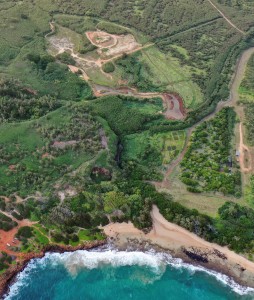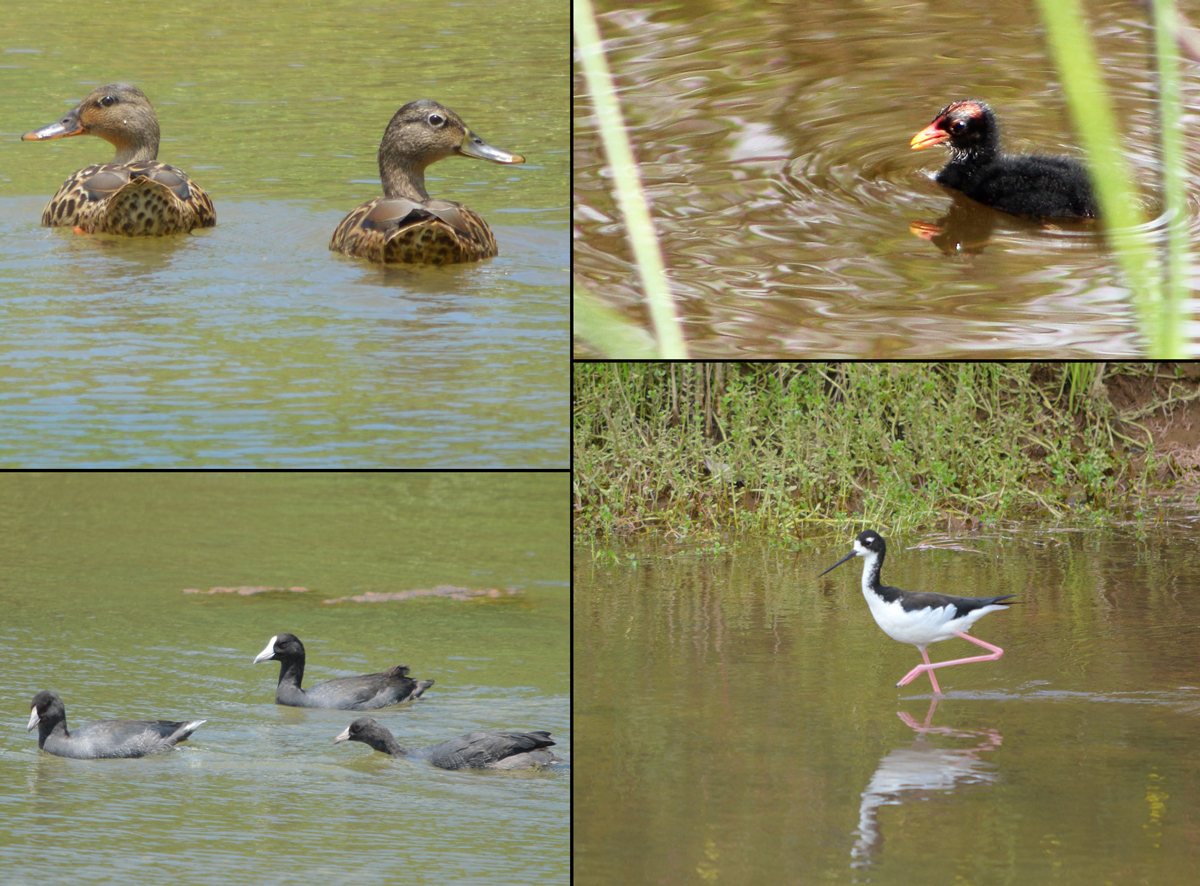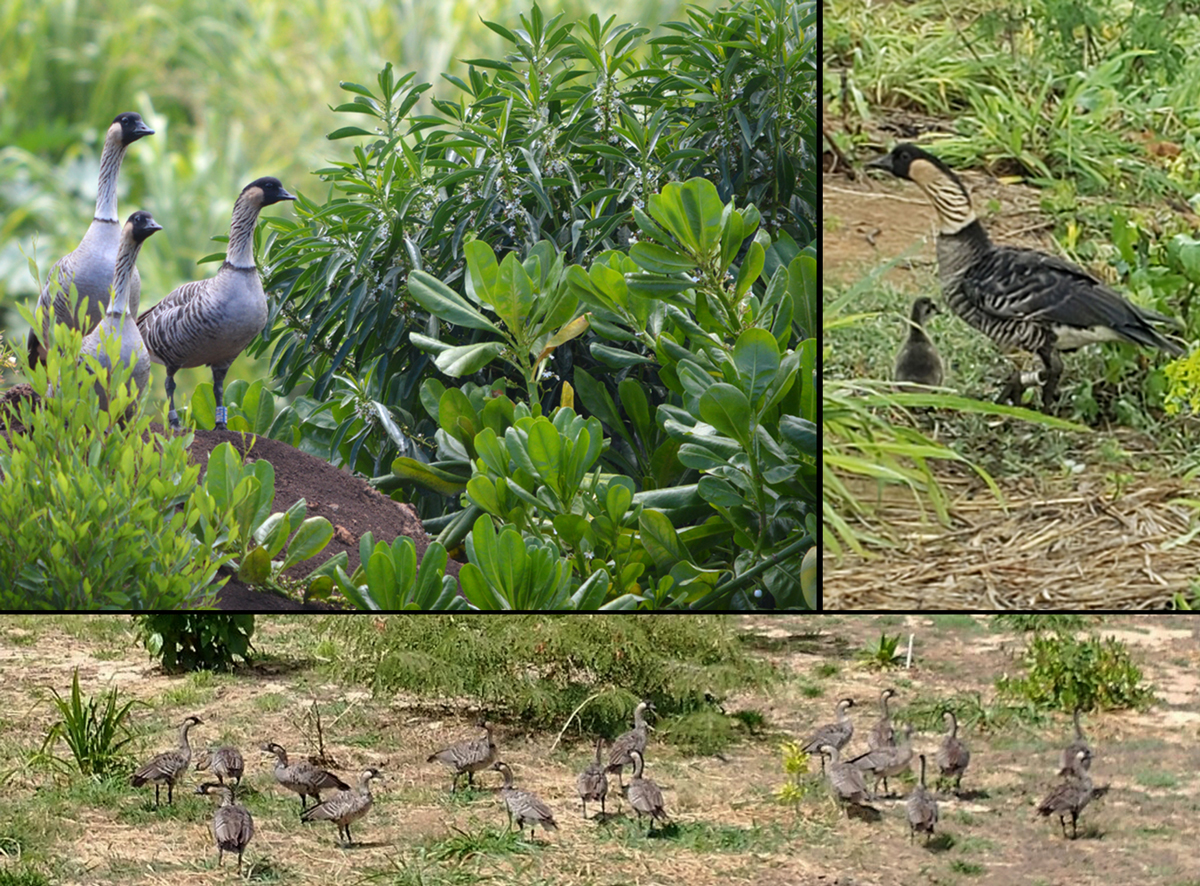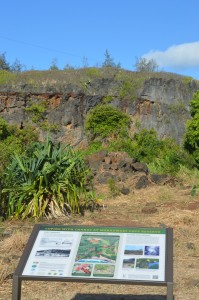After all this… Makauwahi Cave Reserve still thrives!
January 19, 2022

Recent oblique aerial drone imagery showing Makauwahi Cave Reserve with new quarry restorations in background, including three new ponds, native dry forest restorations, and new perimeter fence to exclude pigs and dogs. (Photo by Graham Talaber)
Over the centuries, Makauwahi Cave has recorded all kinds of disasters in its sediment layers. Abundant evidence for hurricanes, a tsunami, floods, extinction events, warfare, and erosion are all there. What will the sediments of our time record? Perhaps some archaeologist of the future will uncover there a thin layer containing…face masks and hand sanitizer!
Since March of 2020, life at the cave has been under the powerful thumb of the COVID-19 pandemic. So far, it has not stopped progress at the cave in research, conservation, or public outreach. Like virtually every place on earth, visitation has been affected. We have had many months when all visitation was local, then additional months of limited public access for visitors from off-island, including masks and social distancing. It has been a tough 22 months, and counting, but the Reserve has gone on thriving despite the perturbations of the human world.
Just as things were about to fall apart in early 2020, we were excitedly initiating a new project sponsored by the Wildlife Conservation Society’s Climate Adaptation Fund and the Doris Duke Foundation, entitled “Coping with Climate Change at Makauwahi Cave Reserve.” The plan was to use the abandoned limestone quarry next to the cave as the substrate for building three new wetlands and planting a native plant reforestation project. We did this, and with additional support from County, State, and Federal sources were able to do a lot more in the Reserve, including building new low-impact composting toilet facilities, installing four wash stations around the property for improved public hygiene, constructing a new maintenance building, and creating a parking lot for visiting buses and overflow parking.

Four species of endangered native waterbirds moved in almost as soon as the new ponds were finished. Clockwise from upper left: Hawaiian Ducks, or koloa maoli; downy chick of Hawaiian Moorhen or `alae `ula; Hawaiian Stilt or ae`o; and Hawaiian Coots or `alae kea. (Moorhen photo by Jerry Keesee, all others by Lida Pigott Burney)
We next embarked on construction of over 3500 feet of panel fence around the new wetlands and forest restorations in the old quarry. With the help of the Partners for Fish and Wildlife program of the US Fish and Wildlife Service and an EQIP grant from the USDA Natural Resources Conservation Service, we built a wonderful fence to keep out pigs and dogs. By this time, the COVID impacts on Kaua`i tourism were in full force, with massive lay-offs in tourist-related industries throughout the island. We were able to get the additional labor we needed for building the fence and other big projects through jobs programs for unemployed residents. We participated in the CARES Act and Rise to Work programs administered by the County, to provide 15 local persons with temporary employment at MCR.
We built that fence, and so far, have planted 4,059 native trees and shrubs in the new restorations. One goal was to provide safe, high-quality habitat for four endangered species of native waterbirds, as well as the Nene. How did that work out? Now, within just two years of its inception, the quarry restoration has been enthusiastically occupied by Hawaiian Moorhens or `alae `ula, Hawaiian Ducks or koloa maoli, Hawaiian Coots or `alae kea, and Hawaiian Stilts or ae`o. The first three species are nesting successfully there already. Flocks of literally dozens of Nene are stopping off, and some have stayed and nested. All in just two years!

Top left, Nene have fully occupied the new forest restorations in the quarry for feeding and resting (photo by Lida Pigott Burney); top right, Nene pair with a small gosling (photo by Laura Manser); Bottom, large flocks of Nene frequent the restorations, including this group of 18 adults (photo by Billie Dawson).
Meanwhile, all our public visitation has, for two years now, been foot-traffic. Since shortly before the beginning of the pandemic, landowner Grove Farm Company locked the gates to our public access road (the road from the Hyatt Hotel down to Maha`ulepu Beach) and it hasn’t opened since. Folks can get within about 3/8 mile (0.6 km), park behind the CJM Stables rodeo stand, and walk down the Makauwahi Cave Trail, our self-guiding nature trail. For a bigger adventure, many of our visitors these past two years have hiked the Maha`ulepu Heritage Trail from the Hyatt, a round trip of roughly four miles.
And yet in the last few months we have recorded our highest visitation rates ever. At the rate of the last three months, we will have a total of over 75,000 visitors or more this coming year, road or no road. Our main regret is that, with the road closure, we can only offer Reserve access to those who can hike in.

New wayside exhibit at Makauwahi Cave Reserve interprets the quarry restorations and other initiatives on the Reserve that are designed to adapt to the local challenges of climate change. (Photo by Lida Pigott Burney)
At the same time, our outreach has continued via our multi-faceted interpretive program. One conspicuous new addition has been the creation of a large wayside exhibit entitled “Coping with Change at Makauwahi Cave Reserve.” (Click Here to see the exhibit) This outdoor exhibit panel provides information from old maps and 19th Century photos concerning changes of the past, poses the current challenges from hurricanes, fire, flooding, and sea-level rise, and reports on our recent progress in designing and constructing restorations that attempt to take these accelerating factors into account. Through Zoom talks, webinars, Facebook posts, and other COVID-era means, we have spread the word that there are things all conservation-minded people in Hawaii and beyond can do to try to mitigate and adapt to climate change.
So MCR’s staff is feeling fairly confident lately, in spite of a two-year challenge from COVID and all that came with it. The resounding success with the new wetlands and forest restorations has emboldened us to literally reach higher. We hope, over the coming year, to raise the funds to convert the little rocky volcanic hill next to the reserve entrance into a seabird nest site restoration. Our colleagues Helen and Andre Raine, seabird experts with Archipelago Research and Conservation LLC, believe that, with a predator-proof fence around it and the right application of social attraction technology (recorded calls, etc.) and suitable nest-chambers, we can convince endangered seabirds to nest here. Our particular focus is on three species that frequent the area but need protection from predators, artificial lights, and human disturbance: Hawaiian Petrel, Newell’s Shearwater, and Band-rumped Storm-petrel.

Oblique aerial drone image of Pu`u Keke, proposed site for a seabird restoration project at Makauwahi Cave Reserve. Mt. Haupu in the background has unprotected nesting sites of endangered seabirds. We hope to attract Hawaiian Petrels, Newell’s Shearwaters, and Band-rumped Storm-petrels. (Photo by Andre Raine)
This may be a great idea, but it will cost a lot of money, especially for the fence. MCR staff members have found a few native plants there, and hope to enhance these populations and create others with some of the more than 7,718 native plants produced this year in our nursery. Like the five native waterbird species we have brought back to the area, these three seabirds and several others were a prominent part of the uniquely rich fossil record of Makauwahi Cave, showing that they thrived here for millennia and presumably could once again with our help.